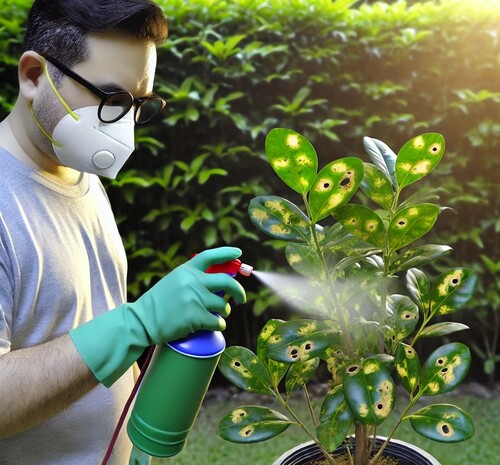Pest Control through Integrated Pest Management (IPM)
Introduction
Integrated Pest Management (IPM) is a sustainable and environmentally sensitive approach to pest control that combines multiple strategies to prevent and manage pest problems effectively. By focusing on the life cycles of pests and their interactions with the environment, IPM aims to minimize damage to plants, homes, and the surrounding ecosystem using the most economical and least hazardous methods available.
Understanding Integrated Pest Management (IPM)
IPM is a holistic approach to pest control that goes beyond simply applying pesticides. It involves using a combination of techniques that prioritize prevention, monitoring, and control. Pesticides are considered only when absolutely necessary, and even then, the least toxic options are preferred. By integrating various methods, IPM reduces the reliance on chemicals and promotes sustainable long-term pest management.
The Core Components of IPM

A Tent Caterpillar Devouring a Leaf Under Warm Sunlight
1. Accurate Pest Identification
Correctly identifying pests is the first step in an effective IPM program. Knowing exactly what pest you’re dealing with allows you to choose the most effective management strategy. Misidentification can lead to ineffective control measures, wasting time and resources. If you’re unsure about the type of pest, consult resources like your local UC Cooperative Extension Office or online tools that provide pest identification services.
2. Prevention: The First Line of Defense
Preventing pests from becoming a problem in the first place is a cornerstone of IPM. This involves creating an environment that is inhospitable to pests by removing their sources of food, water, and shelter. For example, sealing cracks in buildings, eliminating standing water, and using pest-resistant plant varieties are all effective preventive measures.
Implementing IPM in Your Home and Garden

Gardener Raking Autumn Leaves in a Pristine Yard
To effectively manage pests, it’s important to combine several methods from different categories. Here’s how you can implement IPM around your home and garden:
1. Good Gardening Practices
Maintaining a healthy garden is key to preventing pest infestations. Some standard practices include:
- Removing Debris and Infested Plant Material: Regularly clean up fallen leaves, branches, and other debris where pests can hide and breed.
- Proper Watering and Fertilizing: Overwatering or underfertilizing can stress plants, making them more susceptible to pests.
- Growing Competitive Plants: Planting species that outcompete pests can reduce the need for chemical interventions.
- Using Pest-Resistant Varieties: Select plants that are naturally resistant to common pests in your area.
2. Physical or Mechanical Controls
Physical methods and mechanical devices can be highly effective in controlling pests without chemicals:
- Water Sprays: For small insects like aphids , a strong spray of water can dislodge and kill pests.
- Barriers and Traps: Using barriers, such as row covers, and traps, such as sticky traps, can prevent pests from reaching your plants.
- Cultivation Techniques: Regularly tilling the soil can disrupt the life cycles of soil-dwelling pests.
3. Soil Solarization
Soil solarization is an eco-friendly method that uses the sun’s energy to control soilborne pests. By covering the ground with a clear tarp, the sun heats the soil to temperatures that kill harmful bacteria, fungi, insects, nematodes, mites, weeds, and weed seeds. This method is particularly effective in warm climates and can significantly reduce the need for chemical treatments.
4. Biological Control
Biological control involves using natural enemies to manage pest populations. By encouraging the presence of beneficial organisms like ladybugs, parasitic wasps, and predatory mites, you can keep pest populations in check. Planting flowering and nectar-producing plants can attract these beneficial insects, while avoiding the use of broad-spectrum pesticides will help preserve their populations.
When and How to use Pesticides in IPM

Gardener Applying Pesticide to Protect Plants in Sunlit Garden
Pesticides should be considered a last resort in an IPM program. Before using any chemical control, ensure that the pest problem is severe enough to warrant it and that all other methods have been exhausted. When choosing a pesticide, opt for the least toxic, yet effective, option available. Always follow these best practices:
- Use Pesticides Responsibly: Apply pesticides only when necessary and in targeted areas to minimize exposure to non-target organisms, including humans and pets.
- Combine Pesticides with Other Methods: Even when pesticides are used, continue implementing preventive and non-chemical methods to maintain long-term control.
- Monitor and Adjust: After applying pesticides, monitor the pest situation and adjust your methods as needed to prevent future infestations.
Conclusion: Sustainable Pest Control with IPM
Integrated Pest Management (IPM) is not just about controlling pests; it’s about creating a balanced environment where plants can thrive with minimal chemical intervention. By combining prevention, good gardening practices, physical controls, and, when necessary, responsible pesticide use, you can effectively manage pests in an environmentally responsible way.
For more solutions on maintaining a healthy garden, contact Arborist Now . As a professional tree care company serving the San Francisco Bay Area, we specialize in environmentally friendly pest control and garden care. Let us help you create a flourishing pest-free garden that you can enjoy year-round.
Originally posted on September 14, 2020.


